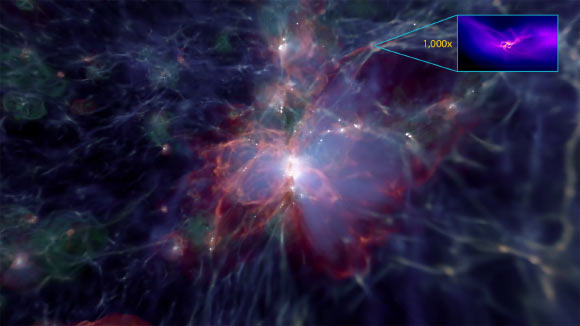When the Universe was less than 1 billion years old, some of its stars turned into supermassive black holes. A key mystery in astronomy has been: why are there so many huge black holes in the early Universe? A new simulation-based study, published in the journal Nature, suggests that massive black holes thrive when galaxies form very quickly. The study also finds that these black holes are much more common in the Universe than previously thought.

A 30,000 light-year region from the Renaissance Simulation centered on a cluster of young galaxies that generate radiation (white) and metals (green) while heating the surrounding gas. A dark matter halo just outside this heated region forms three supermassive stars (inset) each over 1,000 times the mass of our Sun that will quickly collapse into massive black holes and eventually supermassive black holes over billions of years. Image credit: Advanced Visualization Lab, National Center for Supercomputing Applications.
Dark matter collapses into halos that are the gravitational glue for all galaxies.
Early rapid growth of these halos prevented the formation of stars that would have competed with black holes for gaseous matter flowing into the area.
“The key criteria for determining where massive black holes formed during the Universe’s infancy relates to the rapid growth of pre-galactic gas clouds that are the forerunners of all present-day galaxies, meaning that most supermassive black holes have a common origin forming in this newly discovered scenario,” said study lead author Dr. John Wise, a researcher at the Center for Relativistic Astrophysics in Georgia Tech’s School of Physics.
“In the study, we have uncovered a totally new mechanism that sparks the formation of massive black holes in particular dark matter halos,” he said.
“Instead of just considering radiation, we need to look at how quickly the halos grow. We don’t need that much physics to understand it — just how the dark matter is distributed and how gravity will affect that. Forming a massive black hole requires being in a rare region with an intense convergence of matter.”
The previously accepted paradigm was that massive black holes could only form when exposed to high levels of nearby radiation.
“Previous theories suggested this should only happen when the sites were exposed to high levels of star-formation killing radiation,” said study co-author Dr. John Regan, research fellow in the Centre for Astrophysics and Relativity in Dublin City University.
“As we delved deeper, we saw that these sites were undergoing a period of extremely rapid growth. That was the key.”
“The earlier theory relied on intense UV radiation from a nearby galaxy to inhibit the formation of stars in the black hole-forming halo,” said study co-author Dr. Michael Norman, director of the San Diego Supercomputer Center at the University of California, San Diego.
“While UV radiation is still a factor, our work has shown that it is not the dominant factor, at least in our simulations.”
The study was based on the Renaissance Simulation suite, a 70-terabyte data set created on the Blue Waters supercomputer between 2011 and 2014 to help scientists understand how the Universe evolved during its early years.
To learn more about specific regions where massive black holes were likely to develop, the team examined the simulation data and found ten specific dark matter halos that should have formed stars given their masses but only contained a dense gas cloud.
The scientists then re-simulated two of those halos — each about 2,400 light-years across — at much higher resolution to understand details of what was happening in them 270 million years after the Big Bang.
The improved resolution of the simulation done for two candidate regions allowed the researchers to see turbulence and the inflow of gas and clumps of matter forming as the black hole precursors began to condense and spin. Their growth rate was dramatic.
“Astronomers observe supermassive black holes that have grown to a billion solar masses in 800 million years. Doing that required an intense convergence of mass in that region. You would expect that in regions where galaxies were forming at very early times,” Dr. Wise said.
Another aspect of the research is that the halos that give birth to black holes may be more common than previously believed.
“An exciting component of this work is the discovery that these types of halos, though rare, may be common enough,” said Michigan State University’s Professor Brian O’Shea, co-author of the study.
“We predict that this scenario would happen enough to be the origin of the most massive black holes that are observed, both early in the Universe and in galaxies at the present day.”
_____
John H. Wise et al. Formation of massive black holes in rapidly growing pre-galactic gas clouds. Nature, published online January 23, 2019; doi: 10.1038/s41586-019-0873-4







